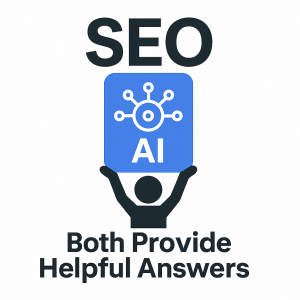 This blog was inspired by an event I attended this past month that featured various AI consultants speaking. These days, one of these guys is guiding AI everywhere you turn. One wonders, where did these expert AI consultants suddenly come from?
This blog was inspired by an event I attended this past month that featured various AI consultants speaking. These days, one of these guys is guiding AI everywhere you turn. One wonders, where did these expert AI consultants suddenly come from?
As a leader in the digital marketing space, the first golden nugget I will drop in this blog is that if you are at a conference, listening to a keynote who projects as an authority, always fact-check, especially if the subject matter is technology.
We listened to many fallacies. The biggest one was the suggestion that AIO would replace SEO, which showed a complete misunderstanding of what SEO today looks like. A best practice in SEO today is helpful content, and Google’s algorithm preferences are the same. Clients who adopt a helpful content strategy achieve strong results on search engines like ChatGPT.
In a fast-changing technology environment, AI doesn’t aim to replace search; search already uses AI in all aspects of its algorithm.
In the age of AI-generated content and ever-evolving search engine algorithms, the real magic lies in understanding how these two forces can work together to achieve the best results.
The Difference Between SEO and AIO
Search Engine Optimization (SEO) is the long-standing practice of tailoring your content to rank well on search engines like Google and Bing. This includes using strategic keywords, meta tags, quality backlinks, and formatting to improve visibility.
AI Optimization (AIO), on the other hand, is a newer frontier. It’s the process of creating and structuring content so it’s easily interpreted and surfaced by generative AI tools — such as ChatGPT, Bard, or Perplexity. AIO focuses on clarity, context, authority, and usefulness.
Not Competing. Collaborating.
Contrary to popular belief, AI isn’t replacing search; it’s enhancing how we experience it. Think of traditional SEO as the road map and AI as the GPS guiding users more intelligently to their destination.
The two are intertwined. For example, AI often pulls its responses from well-optimized websites — so SEO feeds AIO.
Let’s say a potential customer asks ChatGPT, “What’s the best performance marketing tool for multi-location businesses?” AI will surface your brand if your content is authoritative and well-structured and answers that question. We’ve even had clients close deals that originated from ChatGPT-generated leads.
Content That Ranks (and Gets Referred)
To optimize for both SEO and AI:
- Answer questions clearly and concisely
- Use headings, bullet points, and structured data
- Provide valuable, unique insights, not just fluff
- Keep your tone natural, informative, and human-first
- Ensure your content is up-to-date and trustworthy
Google’s Helpful Content update and AI tools prioritize authentic, helpful, and actionable content. If done right, this alignment means that one piece of content can serve two masters.
How We Create Alignment
At Pulsion, we’re building strategies that simultaneously optimize content for search engine visibility and AI discoverability. This includes keyword + query analysis, structuring information clearly, and ensuring your brand has digital authority across channels.
Our hybrid SEO-AIO approach is already paying off — with some clients seeing increased traffic, stronger AI tool mentions, and qualified leads landing in their inboxes from sources like ChatGPT.
Ready to Optimize Smarter?
If you’re wondering how to beef up your optimization to meet human and machine needs — we’re here to help. Visit www.gopulsion.io.